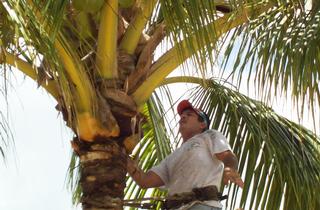Blog
Preparing Beds for Winter Annual Flowers
09/28/2013 09:57 October is a great time to plant winter annual flowers and add fresh color to your overall landscape scheme. In southwest Florida, we have the pleasure of enjoying fall/winter annual plantings until at least mid-spring for many annual varieties.
October is a great time to plant winter annual flowers and add fresh color to your overall landscape scheme. In southwest Florida, we have the pleasure of enjoying fall/winter annual plantings until at least mid-spring for many annual varieties.
So what's the trick for getting the most longevity out of winter annuals?
For most of us in southwest Florida, we are so used to plants and trees growing so steadily that we hardly notice if a couple decline or slow down during the winter months. But since annual flowers are typically a part of a seasonal rotation of prominent, blooming color in our residential and commercial landscaping, we often just assume we'll have no choice but to replace these plants every change of season (spring, summer, etc.).
Not true necessarily. With some minimal up front soil preparation before planting your winter annuals, you can prolong the health and beauty of your plantings, until the heat is turned up outside!
Here's what to do:
-
Before soil preparation, decide if nematodes (microscopic worms) have invaded the space of your annual beds. If you suspect their presence, treat the soil with a fumigant.
-
Several weeks before planting, till or spade the soil in your beds 6” deep.
-
Add some compost or other organic matter (“planting mix”) and mix it with the existing soil.
-
Now you're ready to plant! For many annual flowering plants, October and November are great months for planting. Some annuals will last through early summer months, if the soil is prepared properly and the plants are adequately watered and fertilized through the winter/spring season. Enjoy!
-
Stayed tuned!
-
We'll be sharing our favorite picks for winter annuals for long-lasting color in the next few days!
-

-
Cooling Off With Shade Trees
09/22/2013 13:17Did you know that 45% of the energy used in South Florida in residential settings is used to cool and heat our homes? Shade trees placed appropriately in the landscape can help to conserve energy use and save money.
Planting shade trees on the east and west sides of your home will assist in shading out the more direct sunlight these exposures receive during the heat of the summer months. Shade trees located next to windows and sliding or other doors help to decrease energy lost through these less insulated areas around the perimeter of the home.
Providing shade over and around your air conditioning unit, without restricting airflow to the unit, will also assist in conserving energy during the summer months. The heat loss from your home in the winter months will also decrease when shade trees are properly located for conservation of energy.
There are many shade trees available for South Florida landscapes. Here are a few of our favorites:
Hong Kong Orchid
Royal Poinciana
Golden Shower
Black Olive
Pond Apple
Gumbo Limbo
Also, remember that the closer a shade tree is planted to the house, the more benefits it will provide. However, when locating your planting site, keep in mind that some shade trees grow larger than others and be sure to place the trees according to their mature size to avoid excessive maintenance costs down the road.

Your Neighbor's Palms Will Thank You!
09/14/2013 18:32Your Neighbor's Palms Will Thank You !
It's like a flu or a cold. Once one has it, it's only a matter of time before your neighbor gets it too. Ganoderma butt rot is a fungal disease of palms that acts like a flu the way it spreads from palm tree to palm tree. It decorates your trees with mushroom look-alikes (called conks) and eventually your palms will start to wilt. This fungus attacks the lower 4'-5' of the interior trunk of palm trees. Ganoderma infection results in a gradual decline in health and later death of palm trees.
Ganoderma butt rot of palms is more prevalent in the southern half of Florida and no palm species is resistant to attack by the fungus. Only a very few tree species outside the palm family have been found afflicted by this disease. Even then, it's rare to see any tree but a palm with Ganoderma.
Your initial clue that you have a palm tree suffering from this disease is the appearance of conks on the trunk. At first glance, conks look like mushrooms on the tree - but look closer and you'll see these conks have their own unique, irregular shape and they change from white to a reddish-brown in color as they grow and mature. As Ganoderma lingers in your palm, it will continue to damage the tissues inside the trunk and begin to affect the tree's ability to uptake water through its vascular system. The leaves of the palm will start to wilt, sometimes to the point where only the main spear leaf has a normal appearance and avoids the droopy look.
Researchers believe the wind is responsible for most of the spread of the Ganoderma fungus. Microscopic spores produced on the underside of the conks are released into the air and swept away to other hosts in the wind. Once Ganoderma finds another host palm tree that is susceptible, it begins its attack and yet another tree rides the road to decline. Whether or not a palm tree is damaged by the fungus does not seem to be dependent on the health or lack of health of the tree infected. Thriving palms have been known to suffer from Ganoderma just as often as those under stress.
So far there is no preventive measure or cure for Ganoderma butt rot. The only way to assist your palms in escaping this infectious disease is to keep your eyes open for other palms in your area showing symptoms and check your palms frequently for obvious signs of it - most obvious are the appearance of the conks and moderate to severe leaf wilt. Your palms may or may not be susceptible to Ganoderma, and there is no way to test them to determine their viability in fighting this fungus.
Your neighbor's palm trees will thank you when you remove your palm tree infected with Ganoderma. You don't have to wait for it to die - removal is best when the fungus infection is identified and the sooner, the better. Also, don't even consider a new palm planting in the same area - Ganoderma resides in the soil too and most likely your new palm will be on its way out shortly as well!
Oh, and if you're not up to informing your neighbor about their palm that is showing signs of Ganoderma - just share this article! :>)

First blog
09/14/2013 14:50Our new blog has been launched today. Stay focused on it and we will try to keep you informed. You can read new posts on this blog via the RSS feed.



